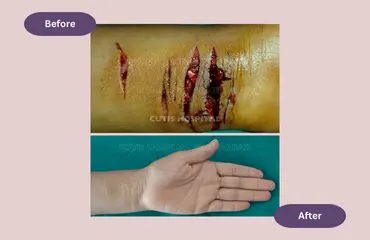Suppose you have had a nerve injury and are having surgery. In that case, you will most likely undergo one of the following kinds of surgery: nerve rehabilitation, nerve graft, nerve transplant, neurolysis, or tendon transmission.
A nerve graft is a patch of nerve tissue that acts as a link to connect two extremities of an injured nerve. Since the graft is transplanted from one region to another, a nerve grafting operation is frequently referred to as a "nerve transplant".
The treatment is intended to repair damaged nerves that carry out critical motor and sensory functions. Bioabsorbable synthetic conduits, processing nerves from cadavers, vein sections, and replaceable nerves from other regions of the patient's body are among the materials utilized for nerve grafting.
Common donor nerves for graft material include the sural nerve, deep radial sensory nerve, and medial antebrachial cutaneous nerve.
The aim of nerve repair treatment when a nerve is injured is typically to reapproximate the endpoints of the affected nerve. Sometimes, after nerve damage, a neuroma, a section of the affected nerve, must be removed, leaving a space. A nerve graft may be required if the nerve endpoints cannot be pulled together.
Typically, nerve grafts are small fragments of sensory nerves taken from another area of the body and utilised as graft material. The regenerated nerve fibers grow from the proximate nerve stump, through the graft, the distal nerve segment, and into the targeted muscles once the graft is in position.
As a result, individuals who had nerve damage repaired with grafts may regain muscle strength.
Nerve graft injury is typically required in cases where a nerve has been damaged or cut, and its ability to transmit signals is impaired. It may occur as a result of traumatic injury, surgical procedures, disease, or congenital conditions.
Some specific conditions that may require nerve graft injury include:
The specific conditions that may require nerve graft injury can vary based on the type and severity of the nerve damage and other factors such as the patient's age and overall health.
When determining whether a nerve graft is the best method for treating nerve injury, a surgeon looks at a number of factors, including:
Time after injury – All nerve repair surgery techniques involving nerve grafting should be completed as soon as possible. If a lot of time goes by after an accident, a nerve graft could no longer be a possibility for restoring function.
Type of injury – Some traumas result in serious nerve damage, necessitating surgical removal of the affected nerve tissue, leaving a gap. However, clean, acute nerve damage, such as a cut from a sharp object, can occasionally be restored by reconnecting the endpoints of the nerve. In addition, a nerve graft could've been utilised to repair the severed nerve.
Length of graft – The length of the graft significantly influences the success of a nerve graft surgery. Results are typically better with shorter grafts than with longer grafts. Your surgeon can suggest alternative methods of nerve repair if the distance separating the ends of a severed nerve is too great to close with a graft.
Risk factors associated with nerve graft surgery include:
It's important to discuss the specific risks and benefits of nerve graft surgery with your doctor to determine if it's the right option for you.
Postoperative care for a nerve graft injury typically involves the following steps:
It is important to follow the doctor's instructions and to attend all scheduled follow-up appointments to ensure the best possible outcome after nerve graft surgery.


Occupational therapy practitioners will regularly monitor patients while using electrical stimulation to assist the nerves in gradually turning back on.
The wounded nerve may take 6 to 12 months to heal and activate its target muscle because nerve cells travel over the graft at a rate of 1 mm each day. Therefore, the parts most distant from the spinal cord’s nerve root heal more slowly than the areas closest to it.
Nerve repair treatments are beneficial for several types of:
When choosing which nerve to use as a donor for the graft, the surgeon takes into account a number of parameters. The way the nerve works is important. Usually, the donor’s nerve provides sensation to a part of the skin where it is not necessary. Occasionally, non-functioning nerve tissue beneath the damage is used for nerve grafts.
Depending on the source of the graft, there are two different types of nerve grafts:
Through the use of cutting-edge surgical procedures and techniques, our team of nerve damage specialists provides best-in-class nerve graft surgery. In addition, our cosmetic and reconstructive surgeons collaborate with neurosurgeons, neurologists, and physiotherapists for the best patient care.
Cutis Hospital is conveniently located in Ghatlodia, Ahmedabad, making it easily accessible via multiple modes of transportation. Below are the various ways you can reach our facility:
Sardar Vallabhbhai Patel International Airport: Located approximately 12.7 km from Cutis Hospital, offering convenient access for patients traveling from outside the city.
Chandlodiya Railway Station: Approximately 2.4 km from Cutis Hospital.
Ahmedabad Railway Station: Around 11 km from our center.
GSRTC:
Ahmedabad Central Bus Station (GSRTC): About 10.3 km from the hospital.
AMTS:
Bhuyangdev Cross Road Bus Stop: Just 500 meters from Cutis Hospital.
BRTS:
Bhuyangdev BRTS Bus Stop: Only 170 meters from our center.
We provide effective surgical and non-surgical treatments for all parts of the body. At Cutis Hospital, our cosmetic and plastic surgery team is committed to giving patients safe and high-quality care.